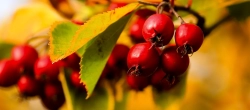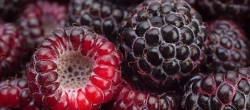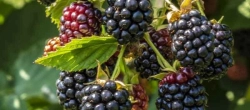Cranberry: Taste, Uses, Benefits and Harm
Cranberries, native to North America, are small, red berries celebrated for their sharp, tangy flavor and high nutritional value. Often used in both sweet and savory dishes, cranberries add a bright, tart element to sauces, baked goods, and beverages. Their high antioxidant content and health benefits make cranberries a popular choice in various cuisines, particularly in North American holiday traditions.

Primary Flavor Characteristics
Cranberries have a distinctly tart, tangy flavor with a slight bitterness. Their sharpness is balanced with a hint of natural sweetness, which is more pronounced when the berries are fully ripe. The intense tartness and slight astringency make them particularly refreshing and ideal for sauces and beverages.
Aromatic and Taste Nuances
Cranberries have a bright, fruity aroma with a mild, earthy undertone. The flavor is sharp and refreshing, with a tartness that can be tempered by sweeteners, making cranberries suitable for both fresh and cooked applications.
Scientific Description of Taste and Aroma
- Aroma: Bright, fruity, with mild earthy notes.
- Taste: Tart, tangy, with a slight bitterness.
- Texture: Firm and juicy, with a crisp, slightly crunchy exterior.
In-Depth Flavor Analysis of Cranberry
Underlying Flavor Notes
Cranberries have a layered flavor profile with multiple dimensions:
- Sharp Tartness: The primary characteristic, providing a refreshing acidity.
- Mild Sweetness: A hint of sweetness balances the tartness, especially in ripe berries.
- Slight Bitterness: The natural bitterness adds depth and complements the tartness.
- Earthy Undertones: Subtle earthy notes add complexity to the bright, tart profile.
Impact of Ripeness on Flavor
- Unripe Cranberry: Firm, with intense tartness and pronounced bitterness.
- Ripe Cranberry: Slightly softer, with a more balanced tartness and mild sweetness.
- Dried Cranberry: Intensely sweet, often used in snacks or baking, with reduced bitterness.
Textural Qualities
Cranberries have a firm, juicy texture with a slight crunch when bitten into. When cooked, they soften, releasing their juices, which makes them ideal for sauces and compotes.
Culinary Uses of Cranberry
Primary Uses
- Sauces and Compotes: Cranberries are often used in sauces for meats, especially in traditional holiday dishes.
- Baked Goods: Cranberries add a tart flavor to muffins, cakes, and breads, providing contrast in sweet pastries.
- Juices and Smoothies: Cranberry juice is a popular beverage, often blended with other fruits for a milder flavor.
- Salads: Dried cranberries add sweetness and texture to salads, pairing well with greens and nuts.
- Cocktails and Beverages: Fresh cranberries are used as garnishes or infused in cocktails, adding a festive touch.
Ideal Pairings for Cranberry
- Citrus Fruits: Orange and lemon enhance cranberry’s natural acidity and brightness.
- Spices: Cinnamon, nutmeg, and cloves add warmth, balancing the tartness in cranberry dishes.
- Apples and Pears: These fruits add natural sweetness and texture, complementing cranberry’s tartness in desserts.
- Nuts: Walnuts, pecans, and almonds add an earthy crunch that balances cranberries in salads and baked goods.
- Herbs: Rosemary and thyme add a savory, aromatic contrast in cranberry sauces and roasted dishes.
Health Benefits of Cranberry
Key Nutrients and Benefits
- High in Antioxidants: Cranberries are rich in antioxidants, including vitamin C and flavonoids, which support immune health and reduce inflammation.
- Supports Urinary Health: Cranberries contain compounds that may help prevent urinary tract infections (UTIs).
- Rich in Fiber: The fiber in cranberries supports digestion and helps maintain stable blood sugar levels.
- Vitamin C and E: These vitamins support skin health, immunity, and cellular health.
- Heart Health Benefits: Cranberries may help improve cholesterol levels and support cardiovascular health.
Potential Precautions
- Tartness Sensitivity: Cranberries’ sharp tartness may be too intense for some; adding sweeteners can reduce this effect.
- Digestive Sensitivity: Some people may experience digestive discomfort from cranberries due to their fiber and acidity.
- High Sugar in Dried Cranberries: Dried cranberries often contain added sugar, so choose unsweetened varieties if monitoring sugar intake.

Tips for Choosing and Storing Cranberry
How to Choose Quality Cranberries
- Color and Firmness: Look for firm, bright red cranberries without wrinkles or soft spots.
- Freshness Check: Fresh cranberries should bounce when dropped, indicating good texture and ripeness.
Storage Recommendations
- Refrigeration: Store fresh cranberries in the refrigerator for up to a month.
- Freezing: Cranberries freeze well and can be stored for several months, ideal for use in sauces and baking.
Fun Facts About Cranberry
- Native to North America: Cranberries have a long history in North American cuisine and were used by Native Americans for food and medicine.
- Air Pockets: Cranberries contain small air pockets, allowing them to float on water and bounce when dropped.
- Traditional Holiday Staple: Cranberry sauce is a popular dish in holiday meals, especially during Thanksgiving in the United States.









